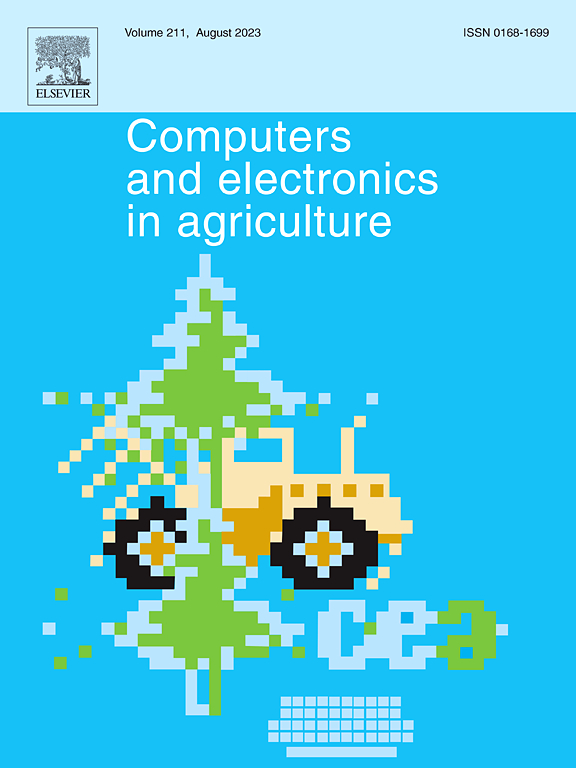Time-space-angle scale effects and incorporation patterns in estimating rice LAI and leaf chlorophyll content by UAV multispectral remote sensing
IF 7.7
1区 农林科学
Q1 AGRICULTURE, MULTIDISCIPLINARY
引用次数: 0
Abstract
Estimation of leaf area index (LAI) and leaf chlorophyll content (LCC) of rice is of great scientific and practical value for precision agriculture and ecological research, and unmanned aerial vehicle (UAV) remote sensing technology offers an effective monitoring resource. Aiming at the current problems of time–space-angle scale effects and unclear fusion patterns, intensive UAV observations in the field were designed in this paper to acquire different time–space-angle multispectral data (observation altitude range of 50–250 m, time range of 9:00–16:00 local time, and the angles including east, west, south, north, and vertical perspectives) for rice in 12 periods. Through analyzing the effects of canopy normalized difference red edge index (NDRE) variations and time–space-angle scales on the accuracy of LAI and LCC estimation during typical rice periods, it was determined that the utilization of NDRE derived from strong sunlights (backscattering direction) is more conducive to the estimation of rice LAI, whereas NDRE from mild sunlights is more appropriate for the rice LCC estimation. Multi-period rice LAI and LCC were estimated using a deep regression model with multihead attention mechanisms (MHAR) through position embedding and understanding of global and local information. The results demonstrated that the highest model accuracy was achieved by the variable inputs of optimal strategy (the coefficients of determination (R2) = 0.89, the root mean square error (RMSE) = 1.29, relative RMSE (RRMSE) = 16.78 % for LAI estimation and R2 = 0.85, RMSE = 2.06, RRMSE = 5.46 % for LCC estimation), significantly higher than shallow machine learning and deep neural network (DNN) models. Furthermore, the addition of other vegetation indices inputs did not substantially improve the model accuracy. The proposed time–space-angle fusion model provides valuable insights for UAV remote sensing crop monitoring.
无人机多光谱遥感水稻LAI和叶片叶绿素含量估算的时-空-角尺度效应及融合模式
水稻叶面积指数(LAI)和叶片叶绿素含量(LCC)的估算对精准农业和生态研究具有重要的科学和实用价值,而无人机(UAV)遥感技术提供了有效的监测资源。针对目前存在的时空角尺度效应和融合模式不清晰的问题,本文设计了无人机集约野外观测,获取12个时段水稻不同时空角多光谱数据(观测高度50-250 m,时间范围为当地时间9:00-16:00,角度包括东、西、南、北和垂直)。通过分析典型水稻期冠层归一化差红边指数(NDRE)变化和时空角尺度对LAI和LCC估算精度的影响,确定利用强光照(后向散射方向)的NDRE更有利于水稻LAI的估算,而利用温和光照的NDRE更适合水稻LCC的估算。通过位置嵌入和对全局和局部信息的理解,利用具有多头注意机制(MHAR)的深度回归模型估计水稻多期LAI和LCC。结果表明,最优策略的变量输入(决定系数(R2) = 0.89,均方根误差(RMSE) = 1.29, LAI估计的相对RMSE (RRMSE) = 16.78%, LCC估计的R2 = 0.85, RMSE = 2.06, RRMSE = 5.46%)获得了最高的模型精度,显著高于浅层机器学习和深度神经网络(DNN)模型。此外,其他植被指数输入的加入并没有显著提高模型的精度。提出的时-空-角融合模型为无人机遥感作物监测提供了有价值的见解。
本文章由计算机程序翻译,如有差异,请以英文原文为准。
求助全文
约1分钟内获得全文
求助全文
来源期刊

Computers and Electronics in Agriculture
工程技术-计算机:跨学科应用
CiteScore
15.30
自引率
14.50%
发文量
800
审稿时长
62 days
期刊介绍:
Computers and Electronics in Agriculture provides international coverage of advancements in computer hardware, software, electronic instrumentation, and control systems applied to agricultural challenges. Encompassing agronomy, horticulture, forestry, aquaculture, and animal farming, the journal publishes original papers, reviews, and applications notes. It explores the use of computers and electronics in plant or animal agricultural production, covering topics like agricultural soils, water, pests, controlled environments, and waste. The scope extends to on-farm post-harvest operations and relevant technologies, including artificial intelligence, sensors, machine vision, robotics, networking, and simulation modeling. Its companion journal, Smart Agricultural Technology, continues the focus on smart applications in production agriculture.
 求助内容:
求助内容: 应助结果提醒方式:
应助结果提醒方式:


